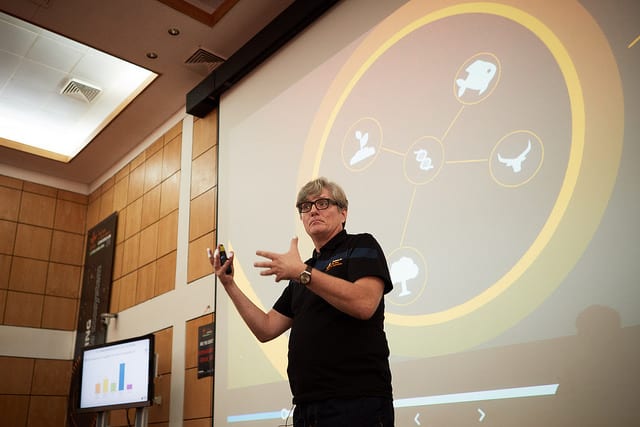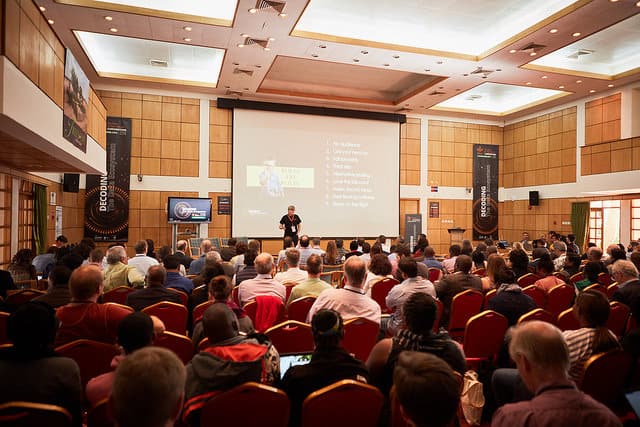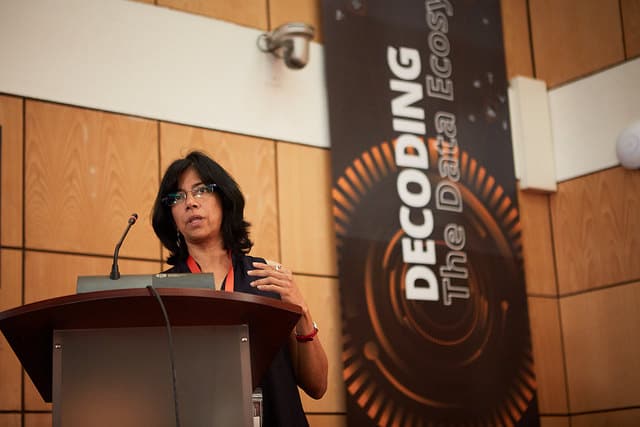Decoding food security at the 2018 Big Data in Agriculture Convention
In order for the tools of big data to be put to use for food security, the data ecosystem must enable dynamic connections between data streams today and tomorrow, equipping all actors in the global food system with new agility and adaptability.

Platform Coordinator Brian King discussing the data ecosystem during the 2018 Platform convention in Nairobi, October 3-5. Photo credit: Juozas Cernius.
The tools of big data have the potential to transform agriculture and address food security challenges around the world by improving how information is collected, combined, analyzed, and shared.
However, there are unique challenges in translating information from food and agriculture systems into interoperable digital formats that can be secured, combined, analyzed, shared by users—from farmers and consumers to policymakers and new “agtech” start-ups—and turned into action.
In order for this transformation to take place, we must invest in the methods and frameworks that enable connecting the tangible world of food and farming with the digital world of data and analytics to generate fluid, adaptable data. Doing so requires us to grapple with the incredible complexity of food systems and wrangle with the explosion of global data generated by research and the course of virtually everyone’s social and economic lives.
A paradigm shift has begun to emerge: in order to spur needed digital transformations in food and farming, we need to consider the whole food system and its interaction with all manner of digital data. We need to consider the whole data ecosystem for food security.
“Fitting together data and tools, actors and types of knowledge we need might be likened to a multidimensional chess game,” says Brian King, the Coordinator of the CGIAR Platform for Big Data in Agriculture. “And when it comes to food security, whether or not we want to, we are all playing this game through the course of our research and our social and economic lives,” says King.
There are powerful new tools for data collection, management, organization, combination, and analysis to handle this complexity. Satellites and telecommunication networks enable researchers to collect high-resolution data across large geographic regions; sensors, drones, and smartphones can capture granular data at specific locations; distributed computing can enable analysis at the edges of the network, giving new power to algorithms for helping us interpret and act in the world. Taken together these technologies help us to generate active loops of machine-aided learning, taking in diverse data streams, producing insights, and capturing the data on our actions in the system.

The 2018 CGIAR Big Data in Agriculture Convention: Decoding the Data Ecosystem, held in Nairobi, Kenya during October 3-5. Photo Credit Juozas Cernius.
King refers to the challenge of developing a more effective data ecosystem—winning the multidimensional chess game—as the key tool for solving wicked problems taking place across a huge number of domains and along a massive scale. The domains knowledge intersecting with food systems include agriculture, market economics, transport logistics, nutrition, and public policy, to name just a few. And the scale of these domains goes from the level of genes and minerals to plants, animals, crops, and herds to whole farm systems, landscapes, local communities, regional and national governments, and ultimately the global scale.
Food intersects with every social, political, and economic system in every community around the world, and for the first time we have the tools to manage this complexity. This is the challenge that experts from the fields of agricultural development, food policy, and data began to unpack at the 2018 CGIAR Big Data in Agriculture Convention: Decoding the Data Ecosystem. The convention, in its second year, took place during 3-5 October at the Nairobi campus of the World Agroforestry Center (ICRAF) and was co-hosted by ICRAF and the International Livestock Research Institute. For three days, almost 400 speakers and attendees came together to envision the role of big data for the future of food security.
The convention is a main event for the CGIAR Platform for Big Data in Agriculture, a cross-network initiative within CGIAR, which is the largest network for global research on food and agriculture. Altogether, the Platform involves 15 Research Centers and 15 Research Programs and Platforms, and more than 8,000 researchers within CGIAR as well as thousands of partners in government and the private sector. Launched last year, the role of the Big Data Platform is to fully integrate the tools and methods of big data analytics into the work of CGIAR and into food and agriculture systems around the world. CGIAR’s mission is to end hunger, poverty, and environmental degradation, and the Platform is working to leverage these tools to accomplish that mission faster, better, and at greater scale.
Take the complexity of on-farm production, an effort made possible by knowledge across domains and scales. Soils, a knowledge domain clearly important for agriculture, can be measured in terms of organic matter, chemical nutrients, water retention, compaction, biological organisms like bacteria, fungi, and earthworms, or types and quality of the crops it produces. The domain of soils interacts with other domains related to agriculture—the qualities and origin of seeds, the management of crops—and many more which are outside the farmer’s control like climate and some pests and disease.

Soil samples at the CIAT office, Selian Agricultural Research Institute, Arusha, Tanzania. Credit: Georgina Smith / CIAT.
Beyond the farm gate, the domain of agriculture intersects with markets, infrastructure, policy, and more. Multiplied by the number of users—from farmers to consumers to everyone in a value chain in between—the data ecosystem for food security becomes massively, overwhelmingly complex. Everyone is an actor at some level, interacting with and changing the overall ecosystem. So, what is the best strategy for converting the global food system—a complex, living system of crops, animals, ecology, weather, markets, governments, and the daily decisions of every single person on the planet—into the digital language of data analytics?
This is where the work of the CGIAR Platform for Big Data in Agriculture comes in. The Platform seeks to connect a massive network of stewards for the digital transformation of CGIAR, the food security enterprise and, ultimately, the global food system. This Platform pursues this transformation through three broad efforts: organizing food and agriculture data to be findable, accessible, interoperable, and reusable; convening stakeholders to use this data and build new capabilities through collaboration; and fostering successful digital innovations in applying big data analytics for food security.
This Convention for Big Data in Agriculture demonstrated all three of those efforts at work. Experts from wide-ranging fields like agronomy, marine fishing ecosystems, livestock health, telecommunications, satellite imagery, blockchain technology, and many areas of data science—from programmers to data managers to machine learning analysts—have come together to raise important issues for moving the data ecosystem for food security forward. A critical objective of the Platform for Big Data in Agriculture is to create a cohort of researchers that have a deep understanding both of agriculture and data science and actively collaborate across domains. This week’s convention has been an important opportunity to develop channels of information sharing across these two disciplines.

Medha Devare addresses participants at the 2018 CGIAR Big Data in Agriculture Convention, Kenya, Kenya during October 3-5. Photo Credit: Juozas Cernius.
Perhaps the biggest issue raised during the convention was the challenge blockages to building the functional data ecosystem for food security. Partly these blockages are due to the lack of digitization in the agricultural sector. But they are also due to the slowly-changing culture of poor data management in the food and agriculture sector.
Medha Devare, a Senior Research Scientist at International Food Policy Research Institute (IFPRI is the leader of the data organization and mobilization efforts for the CGIAR Platform for Big Data in Agriculture.
“We have an embarrassment of research data riches in the agricultural sector, but right now it is scattered and decentralized,” says Devare.
Devare wants researchers in food and agriculture to look to the biotechnology sector for inspiration. For thirty years, computational biologists have been developing a platform for data storage and management, which has resulted in a dramatic increase in research efficiency and important discoveries. For example, the cost of gene sequencing has dropped so significantly in the past 15 years that the company 23andMe can now sequence a person’s genome for less than $100. As Devare emphasizes, data management is not as sexy as writing algorithms and developing artificial intelligence, but in order to get to those kinds of innovations and have a 23andMe for soil or a virtual assistant to provide real-time decision support for farmers, the data ecosystem has to be complete.

A group of local Kenya farmers chat with innovators about digital agriculture tools during the 2018 CGIAR Big Data in Agriculture Convention. Photo Credit: Juozas Cernius.
Another major theme during the convention has been the issue of privacy. These powerful, new data tools work in both directions—for collecting data from farmers and for sharing data back to farmers. They have created a new ethical landscape, especially around the contentious question of data ownership and responsible data use: researchers need real on-farm data if they are to develop the insights and services that will be of use to vulnerable farmers, yet individual privacy must be protected. According to King, the sector should again look to biomedical research, where technologies and ethical practices exist to enable analysis of very specific data about health conditions without ever revealing who has what.
Another key theme of the Convention was data ontologies. They were mentioned in almost every lecture, panel, and break-out discussion. “Ontology” is an arcane and confusing term for most people, yet data ontologies are the connective tissue between types of knowledge, and are fundamental to achieving the agility of analysis and adaptability of action the world’s food system needs. The importance of this work can’t be understated.
Earlier this year, at the 73rd General Assembly of the United Nations, world leaders came together to discuss the critical importance of data for food security. The event, titled “Data to End Hunger,” highlighted a new project to improve the quality of data on smallholder farming systems around the world. Food systems intersect at some point with every one of the UN’s Sustainable Development Goals. Food security through agricultural development is critical for “Zero Hunger” yet it also links with ending poverty, enabling economic growth and job creation, and reducing the impact of humans on the environment.
Every year, billions of dollars of aid are invested in agricultural development, and the work of the research community including CGIAR is essential for guiding this development. The CGIAR Platform for Big Data in Agriculture aims to spur digital transformations across food and farming systems worldwide to accelerate progress towards these goals.
Elliott Brennan
Washington, United States




